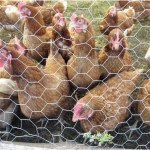Reviewing the CFO Consultation Reports
Posted: August 26, 2015
Categories: GoodFoodBites / News from Sustain Members / News from Sustain Ontario / The Meat Press
Written by Phil Mount, Research Associate, Centre for Sustainable Food Systems
 Between late 2014 and early 2015, Chicken Farmers of Ontario (CFO) consulted with quota-holding and non-quota-holding producers and processors, input suppliers, downstream stakeholders and interested members of the public in 18 facilitated meetings and online. The purpose of the consultations was to develop a broad picture of the recommendations and priorities for the allocation of future growth in Ontario’s share of the national quota for chicken production.
Between late 2014 and early 2015, Chicken Farmers of Ontario (CFO) consulted with quota-holding and non-quota-holding producers and processors, input suppliers, downstream stakeholders and interested members of the public in 18 facilitated meetings and online. The purpose of the consultations was to develop a broad picture of the recommendations and priorities for the allocation of future growth in Ontario’s share of the national quota for chicken production.
One notable outcome of this process was the creation of the Artisanal Chicken Program: Enabling small, independent, locally-based family farms. Through this program, CFO will license farmers to produce and market—without quota—between 600-3,000 meat chickens per year. This program is intended to allow for the growth of local and direct markets in Ontario, which have to date been constrained by the 300 bird exemption limit under the Small Flock program, which remains in place but renamed Family Food—reflecting its intent to allow for on-farm uses only.
(REMINDER: The first application deadline for those wishing to join the new Artisanal Chicken program in 2016 is September 4, 2015. Applications to the new program are available here. Farmers who are currently registered as small flock growers for 2015 to grow 300 chickens or less for home consumption or farm gate sales will be automatically registered in the new Family Food program.)
The new Artisanal program, along with a soon-to-be-created, quota-based Local Niche Markets program, will be counted toward Ontario’s portion of the national allocation. And the impetus for the new programs comes, in part, from what CFO heard in the consultation process.
The majority of the meetings (10) involved quota-holing producers in 9 districts in southern and eastern Ontario. Four further meetings involved the chain partners, including the largest quota-holding processors, Class-B processors, and independent processors, as well as input suppliers. Non-quota-holding producers and the public were consulted in three meetings—including the only one held in northern Ontario—and online.
Along with a general survey of opinions of the state of the existing system, the meetings gauged the responses to three questions: which objectives should be prioritized in allocating growth; to whom should production increases be allocated; and to whom should processing increases be allocated.
When ranking the objectives, most prioritized ‘the evolution of the allocation system’ —a fairly safe if somewhat ambiguous objective. However, two of the processing groups and most of the public groups placed as their top priority ‘the creation of value serving growing and emerging markets’.
Similarly, while the next priorities of quota-holders and large processors were to ‘serve existing markets’ and ‘develop a predictable and stable system’, for smaller processors and the public, the next priority was to ‘encourage innovation’.
On the processor allocation question, there was consistent support across all categories for regional, small, and new processors, as well as those serving niche or specialty markets. In the public consultations, there was also strong support for mobile processing—definitely a file to watch.
The producer allocation question was perhaps the most vexing and contentious, judging by the number of different choices identified in the meetings. Producers and processors favoured distribution to all quota-holders and new entrants. Of note, both producers and smaller processors next selected small flock producers for allocation. In the public consultations—also the only venues for small flock producers to have a voice—the support for small flock producer allocation was massive. While the latter reflected many years of advocacy by small flock producers and organizations across the province—including Sustain Ontario—it’s hard to imagine that the Artisanal Chicken program would have been created without this strong show of support during the CFO consultation process.
Related Reading
CFO Expands New Artisanal Chicken Program Q&A (August 12, 2015)
